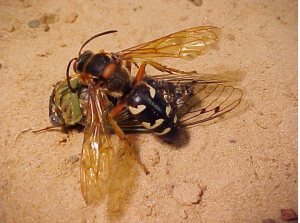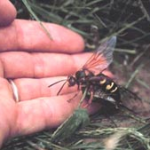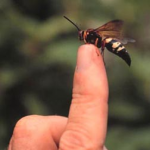Ok, so here’s an insect that is about 2 inches long, as thick as your thumb, looks and sounds like a mini Black hawk helicopter so what’s not to be afraid of? I mean even its name triggers our worst fears.
CICADA KILLER
 Now add to that about 250 of them flying around your yard at low levels like humming birds on steroids and most people run for the hills!
Now add to that about 250 of them flying around your yard at low levels like humming birds on steroids and most people run for the hills!
Each year exterminators from Colorado to New York city get frantic calls regarding these invasions and most often the caller is disappointed by what they’re told. Control measures are very limited when it comes to the cicada killer and most bug guys won’t tackle the job. Instead they tell you that this huge beast is relatively harmless and should be left alone. I don’t know how many times I’ve told someone this and before I know it the phone goes silent and I just know their finger is quickly dialing another number from the book looking for help. The truth is, there is very little you can do.
Things that don’t work
I don’t have any scientific data to back this up but these are things I’ve tried to get rid of the cicada killer but didn’t work.
- Yard sprays
- dusting each hole
- yard foggers
- bug zappers
- citronella candles
- packing dirt back in holes
- granules
- tennis rackets (but not for very long–they get mad)
 About the only thing that will deter them is a nice thick turf as they tend to like sparse and open sandy areas. Cicada killers also come back to the same area each year so once they’ve chosen your yard I’d be breaking out the fertilizer. Cicada killers gather each year by the hundreds in a large group called a Lek. Kind of a big mating party and when they are done the female usually begins to dig her burrow not to far away. This is where she’ll lay her eggs in chambers on a cicada that she has caught, paralyzed and drug down into the hole. Thankfully this frenzied activity only lasts a week or two but underground the eggs hatch in just a few days and the cycle is reborn. The larva eat the cicada and then spin a silken cocoon in which they’ll pupate in over the winter. Adults emerge in late June to July and you guessed it, a Lek party and it’s back to your yard.
About the only thing that will deter them is a nice thick turf as they tend to like sparse and open sandy areas. Cicada killers also come back to the same area each year so once they’ve chosen your yard I’d be breaking out the fertilizer. Cicada killers gather each year by the hundreds in a large group called a Lek. Kind of a big mating party and when they are done the female usually begins to dig her burrow not to far away. This is where she’ll lay her eggs in chambers on a cicada that she has caught, paralyzed and drug down into the hole. Thankfully this frenzied activity only lasts a week or two but underground the eggs hatch in just a few days and the cycle is reborn. The larva eat the cicada and then spin a silken cocoon in which they’ll pupate in over the winter. Adults emerge in late June to July and you guessed it, a Lek party and it’s back to your yard.
Now as exterminators it is our job to try and educate as much as possible and over the years I have demonstrated that this huge wasp is of no harm. I have walked through the buzzing hordes and even had them land on my outstretched hand all the while the lady of the house is shrieking from behind the closed kitchen window. Nothing seems to soothe the fear that these creatures conjure up and if I’m asked once,
 I’m asked 1000 times; “Are you sure there is nothing you can do?” Being licensed in lawn spraying I agree to begin a fertilizer program to thicken the yard so as to discourage next years Lek. I also smile as I show her the receipt and circle ‘insect treatment included’ and even though I’ve gone to great lengths to persuade the lovely lady of the house it is only then that she sighs and shows any sign of relief.
I’m asked 1000 times; “Are you sure there is nothing you can do?” Being licensed in lawn spraying I agree to begin a fertilizer program to thicken the yard so as to discourage next years Lek. I also smile as I show her the receipt and circle ‘insect treatment included’ and even though I’ve gone to great lengths to persuade the lovely lady of the house it is only then that she sighs and shows any sign of relief.




